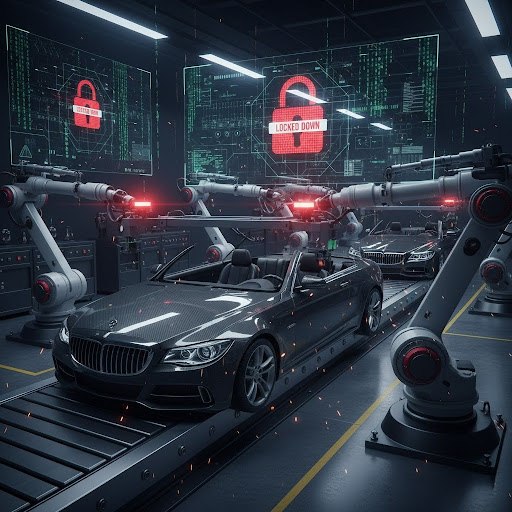In late August 2025, Jaguar Land Rover (JLR) experienced one of the most disruptive cyber incidents in the history of the automotive industry. The attack forced the company to halt production across multiple plants, disrupted global supply chains, and triggered government intervention to stabilize operations. Unlike typical ransomware events, this was not about extortion—it was about systemic disruption.
For executives across industries, the JLR cyberattack is more than a headline. It is a case study in systemic risk, illustrating how digital vulnerabilities can cascade into operational, financial, and reputational crises.This incident serves as a pivotal moment for leadership.
The Anatomy of the Jaguar Land Rover Cyberattack
How the Attack Unfolded
- Initial Access: Attackers exploited a combination of stolen credentials and vulnerabilities in public-facing applications.
- Lateral Movement: Once inside, they moved across JLR’s network, infiltrating both IT and operational technology (OT) systems.
- Disruption: By targeting production control environments, the attackers forced JLR to shut down assembly lines, logistics systems, and delivery networks simultaneously.
Why It Was So Damaging
- Hyper-Connected Systems: JLR’s “smart factory” model, designed for efficiency, created a vast attack surface.
- No Ransom Demand: The absence of financial extortion suggests sabotage, possibly linked to state-backed actors.
- Economic Fallout: Production halts threatened 200,000 jobs, cost hundreds of millions in losses, and required a £1.5 billion government loan guarantee.
Systemic Risk: Beyond Cybersecurity
The JLR incident underscores a critical truth: cyber risk is no longer an IT problem, it is a systemic business risk.
What Is Systemic Risk in the Digital Age?
Systemic risk occurs when a single point of failure cascades across interconnected systems, amplifying disruption. In JLR’s case:
- IT outages crippled manufacturing operations.
- Production stoppages disrupted global supply chains.
- Supplier liquidity crises threatened industry-wide stability.
This is the same logic that governs financial contagion in banking or supply shocks in energy markets. Cybersecurity has now entered that league of systemic vulnerabilities.
Lessons for Organizations: Strategic Takeaways
1. Cybersecurity Is a Boardroom Imperative
- Shift in Accountability: Boards must treat cyber resilience as a fiduciary duty, not a technical detail.
- Integration with Strategy: Cyber risk should be embedded into enterprise risk management (ERM) frameworks, alongside financial, operational, and geopolitical risks.
2. Efficiency Without Resilience Is Fragile
- Lean supply chains and just-in-time manufacturing maximize efficiency but reduce shock absorption.
- Leaders must balance efficiency with redundancy, segmentation, and contingency planning.
3. The Convergence of IT and OT Requires New Defenses
- Traditional cybersecurity focused on IT systems.
- Today, operational technology (OT)—factories, logistics, energy grids—is equally vulnerable.
- Executives must demand integrated IT/OT security strategies.
4. State-Backed Threats Change the Risk Landscape
- The sophistication of the JLR attack suggests geopolitical motives.
- This elevates cyber risk from a criminal nuisance to a national security concern.
- Executives must engage with government, regulators, and industry peers to strengthen collective defense.
Actionable Recommendations for Executive Leaders
To avoid the kind of systemic disruption that paralyzed JLR, executive leaders must champion a cybersecurity strategy that integrates governance, enterprise risk management, and advanced technical controls. The following recommendations are essential to building resilience and safeguarding operations against future shocks:
Strengthen Governance and Oversight
- Establish a cyber risk committee at the board level.
- Align cybersecurity with enterprise risk management and strategic planning.
- Ensure regular reporting on cyber resilience metrics, not just compliance checklists.
Build Resilient Architectures
- Segment networks to prevent lateral movement between IT and OT.
- Adopt zero-trust access models to minimize insider and credential-based risks.
- Invest in redundant systems and offline recovery capabilities to ensure continuity.
Stress-Test for Systemic Scenarios
- Move beyond tabletop exercises focused on ransomware.
- Simulate multi-system outages that test supply chain resilience, customer communication, and financial liquidity.
- Incorporate third-party risk assessments, recognizing that suppliers and partners are often the weakest link.
Elevate the Human Factor
- Cybersecurity is not only about technology.
- Invest in executive training to ensure leaders understand systemic risk.
- Foster a culture of resilience, where employees at all levels recognize their role in safeguarding the enterprise.
Collaborate Beyond the Enterprise
- Engage in industry-wide information sharing on threats and best practices.
- Partner with government agencies to align on national resilience strategies.
- Support supplier financing mechanisms to prevent cascading failures in the value chain.
From Risk Mitigation to Value Creation
Executives often view cybersecurity as a cost center. The JLR incident reframes it as a strategic differentiator. Companies that demonstrate resilience will:
- Win customer trust in an era of heightened digital anxiety.
- Attract investment, as capital markets increasingly reward risk-aware governance.
- Strengthen competitive advantage, by ensuring continuity when rivals falter.
In other words, resilience is not just about avoiding loss, it is about creating value.
Leading in the Age of Systemic Risk
The Jaguar Land Rover cyberattack is a stark reminder that in today’s interconnected economy, the assembly line can stop not because of a broken machine, but because of a broken network.
For business leaders, the lesson is clear:
- Cybersecurity is not a technical silo, it is a strategic, systemic, and existential issue.
- Governance, resilience, and foresight are the new cornerstones of leadership.
- The organizations that thrive will be those that anticipate systemic risks, invest in resilience, and lead with clarity in uncertainty.
The JLR incident is not just a cautionary tale, it is a call to action. The question is not whether other organizations will face systemic disruption, but whether they will be prepared to withstand it and emerge stronger.
For deeper insights on shaping a resilient cybersecurity strategy, our team stands ready to navigate the complexities of today’s digital business landscape with you, helping you transform uncertainty into a strategic advantage.
